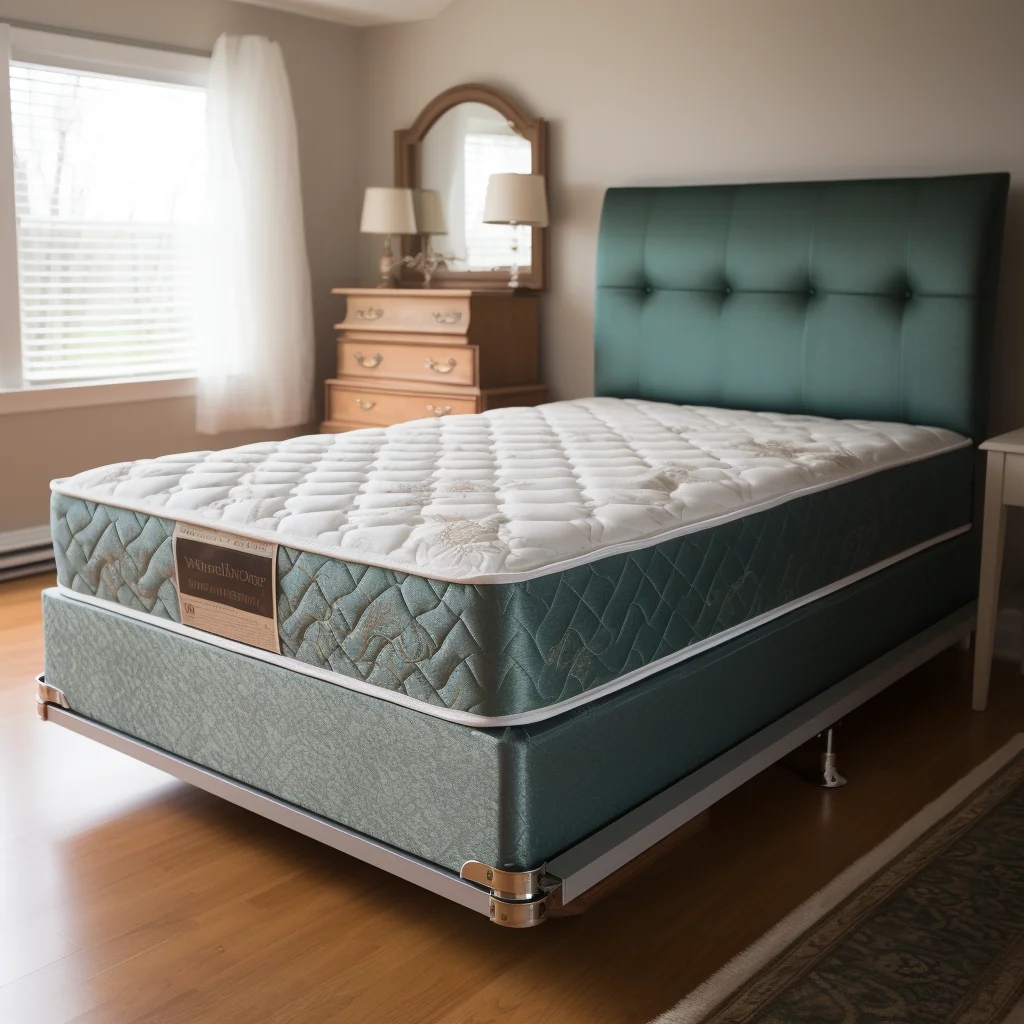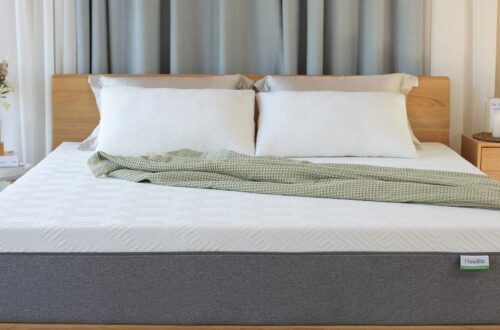The Queen Mattress and Box Spring: 1st Comprehensive Guide

In the realm of sleep, the queen mattress box spring and its trusty companion, the box spring, reign supreme. As a professional mattress producer, I’ve seen the evolution of sleep technology and design firsthand. The queen mattress and box spring combination remains one of the most popular choices for consumers, and good reason. This article delves into the intricacies of the queen mattress and box spring, exploring their history, benefits, and the factors to consider when purchasing.
The queen mattress, measuring 60 inches wide by 80 inches long, has been a staple in the bedding industry for decades. Its origins can be traced back to the mid-20th century when the need for a mattress size between a full and king became evident. As homes grew and couples sought more sleeping space without overwhelming their bedrooms, the queen mattress emerged as the perfect solution.
The box spring, often overlooked, plays a pivotal role in the sleep experience. Originally, box springs were designed to provide a buffer between the mattress and the bed frame, absorbing shock and reducing wear on the mattress. Over time, their function has evolved. Today, they provide support, elevate the bed to a comfortable height, and ensure proper ventilation.
Benefits of the Queen Mattress and Box Spring Combination
-
- Optimal Size: The queen mattress offers ample space for couples, ensuring each individual has enough room to move without disturbing the other. It’s also an excellent choice for singles who enjoy extra space.
- Durability: The combination of a queen mattress and box spring distributes weight evenly, reducing pressure points and extending the life of the bed.
- Aesthetic Appeal: A queen-sized bed fits well in most modern bedrooms, balancing comfort and aesthetics.
- Versatility: Suitable for guest rooms, master bedrooms, or even upscale hotels, the queen mattress is versatile in its application.
Factors to Consider When Purchasing
- Type of Mattress: From memory foam to innerspring mattress and box spring, latex to hybrid, the material and construction of the bed play a significant role in comfort and support.
- Box Spring Construction: While traditional box springs are made of wood and coils, newer foundations might be made of metal or a combination of materials. Choose one that complements your mattress type.
- Firmness Level: This is subjective and varies from person to person. It’s essential to test the mattress or read reviews to determine the right firmness for your sleep style.
- Budget: Queen mattresses and box springs come in various price points. Set a budget, but be prepared to invest in quality for longevity and comfort.
- Warranty and Trial Period: Always check for a good warranty and a trial period. This ensures you’re protected against defects and can test the mattress in your home.
To maximize the lifespan of your sleep setup:
- Rotate your mattress every 3-6 months.
- Use a mattress protector to guard against spills and allergens.
- Ensure your bed frame provides adequate support.
- Vacuum the mattress surface occasionally to remove dust and allergens.
- Avoid jumping or placing heavy objects on the bed to prevent damage.
Over the years, the materials used in queen mattresses have evolved significantly. Here’s a brief overview:
- Innerspring: This traditional mattress type uses steel coils for support. The coils’ number, shape, and design can vary, affecting firmness and support.
- Memory Foam: Introduced in the 1990s, memory foam mattresses are known for their contouring properties. They mold to the body, providing pressure relief and support.
- Latex: Made from the sap of rubber trees, latex mattresses are responsive and offer support and cushioning. They’re also known for being hypoallergenic and eco-friendly.
- Hybrid: Combining the best innerspring and foam or latex, hybrid mattresses offer a balanced feel with support and contouring.
- Airbeds: These use air chambers as their primary support system. Users can adjust the firmness by increasing or decreasing the air.
- Waterbeds: Once a popular choice in the 1970s and 1980s, waterbeds use water as their primary support system.
Box springs have also seen changes in design and construction:
- Traditional: Made of a wooden frame, steel support springs, and a cloth cover.
- Zero-Deflection: Uses a series of steel modules to provide support instead of springs.
- Semi-Flex: Combines metal and wood to create a grid foundation.
The Environmental Impact
As consumers become more eco-conscious, the mattress industry has responded:
- Eco-friendly Materials: Organic cotton, natural latex, and wool are becoming popular choices.
- Recycling Initiatives: Many companies now offer mattress recycling to reduce landfill waste.
- Certifications: Look for certifications like mattress with certipurus certified foam (for foams) or GOTS (for organic textiles) to ensure materials meet specific environmental and health criteria.
The digital age has brought about innovations:
- Innovative Mattresses can track sleep patterns, adjust firmness, or even regulate temperature.
- Adjustable Bases: Paired with a queen mattress, users can elevate the bed’s head or foot for customized comfort.
Different cultures influence mattress preferences:
- European Designs: Known for their sleek, low-profile beds and firmer mattresses.
- Asian Influences: The traditional Japanese futon, though not a queen size, has influenced minimalist and space-saving designs.
Sleep ergonomics refers to the design and arrangement of our sleeping environment to ensure optimal posture and comfort. The queen mattress and box spring play a pivotal role in this:
- Spinal Alignment: A good mattress supports the spine’s natural curve. Whether you’re a side, back, or stomach sleeper, the bed should conform to your body and fill the gaps to maintain alignment.
- Pressure Point Relief: High-quality mattresses distribute weight evenly, preventing pressure buildup in the hips, shoulders, and knees.
- Temperature Regulation: Materials like gel-infused memory foam or natural latex can help regulate body temperature, ensuring a comfortable sleep environment.
The modern consumer values products tailored to their unique needs:
- Split Queen Options: Some manufacturers offer split queen mattresses for couples with different firmness preferences, allowing each side to have a different firmness level.
- Custom Layers: Some brands allow customers to choose the layers inside their mattresses, ensuring a personalized sleep experience.
- Tech Integration: From sleep trackers to heating and cooling systems, mattresses can now be integrated with various technologies to enhance sleep quality.
The Role of Sleep in Overall Health
A quality queen mattress and box spring can significantly impact our health:
- Mental Health: Quality sleep is linked to reduced stress, better mood, and improved mental clarity.
- Physical Health: It aids muscle recovery, immune system function, and weight management.
- Cognitive Function: A good night’s sleep enhances memory, creativity, and problem-solving skills.
The digital age has transformed how we shop for mattresses:
- In-Store: Allows for tactile feedback and immediate queries. However, it can be overwhelming due to numerous options.
- Online: Offers convenience and often a more extended trial period. The challenge lies in purchasing without physically testing the product.
- Hybrid Approach: Some brands have showrooms where customers can test mattresses before ordering online.
The last decade has seen a surge in direct-to-consumer mattress brands:
- Convenience: Delivered to your doorstep, these mattresses are compressed in a box, making transportation and setup easier.
- Cost-Effective: By cutting out intermediaries, these brands often offer competitive prices.
- Extended Trials: Many online brands provide extended sleep trials, some up to a year, ensuring customers can thoroughly test the mattress.
Understanding Different Firmness Levels
The firmness of a mattress plays a crucial role in determining its comfort. While firmness is subjective and varies from person to person, understanding the different levels can help in making an informed choice:
Soft Mattresses
Soft mattresses are plush and provide a sinking feeling. They are ideal for side sleepers as they cushion the shoulders and hips, ensuring proper spinal alignment. However, they might not support heavier individuals or stomach sleepers.
Medium mattresses strike a balance between softness and firmness. They are versatile and suitable for most sleepers, offering support and comfort.
Firm Mattresses
Firm mattresses offer maximum support. They are ideal for back and stomach sleepers, ensuring the spine remains neutral. Heavier individuals might also prefer firm mattresses as they prevent excessive sinking.
Body weight significantly influences how a mattress feels. Lighter individuals might find firm mattresses too hard, while heavier individuals might sink too much on soft beds. Choosing a mattress that provides adequate support and comfort based on body weight is essential.
Box Spring Innovations
While traditional box springs were designed to provide a buffer between the mattress and the bed frame, modern box springs, often referred to as foundations, have seen various innovations:
- Low-Profile Foundations
These are thinner than traditional box springs, ideal for thicker mattresses or those who prefer a lower bed height.
- Split Box Springs
For easy transportation, split box springs come in two halves, especially in tight spaces. They are perfect for queen and king-sized beds.
- Metal Foundations
Metal box spring Wayfair sleepers are durable and provide excellent support. They are also resistant to pests like bed bugs.
With continuous research in sleep science, we now understand the profound impact of sleep on our health and well-being. This has led to innovations in mattress design, ensuring they cater to various sleep needs:
Modern mattresses often feature zone support, where different bed areas provide varying firmness levels. This ensures proper support for the head, shoulders, lumbar region, and legs.
With the understanding that body temperature impacts sleep quality, many mattresses now incorporate cooling technologies. These include gel-infused foams, breathable covers, and phase-change materials that regulate temperature.
For those who tend to sleep or sit on the edge of the bed, edge support is crucial. Reinforced edges prevent sagging and ensure the mattress remains durable.
Importance of Sleep Hygiene
While a good mattress and box spring are essential, maintaining proper sleep hygiene is equally crucial for quality sleep. This includes sticking to a regular sleep schedule, creating a bedtime routine, and ensuring the sleep environment is conducive to rest.
Choosing the right queen mattress and box spring is an investment in health and well-being. Understanding individual needs and preferences is crucial with the myriad of options available. As the world of sleep continues to evolve, consumers are empowered with knowledge and choices, ensuring restful nights and productive days.







